Energy - 1.1.2 Changes in Energy (GCSE Physics AQA)
Changes in Energy
Calculating Energy Changes
In this tutorial we will go through several types of energy changes:
- Moving object – we will look at kinetic energy of a moving object.
- Stretched spring – we will look at the elastic potential energy of a stretched spring.
- Raised object – we will look at the gravitational potential energy of a raised object.
Kinetic Energy, KE
Moving objects have kinetic energy.
Kinetic energy depends on both the speed and mass of the object.
- If two objects have the same speed, the heavier object has more kinetic energy.
- If two objects have the same mass, then the faster moving object has more kinetic energy.
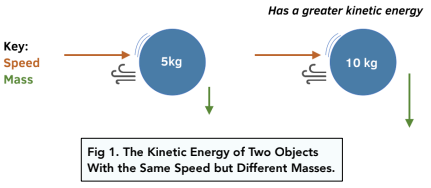
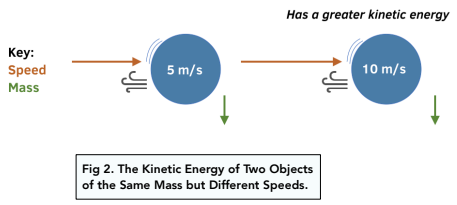
Calculating KE
The kinetic energy of an object can be calculated using the following equation:
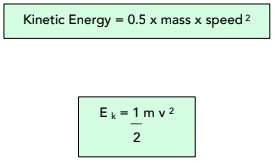
Where:
- kinetic energy, Ek, in joules, J
- mass, m, in kilograms, kg
- speed, v, in metres per second, m/s
Examples: KE Calculations
Question: An armadillo of mass 500kg moves at 5m/s. What is its kinetic energy in kJ?
1. Write out the equation for kinetic energy.

2. Substitute in the numbers.
Put numbers that we already know into the equation.
Kinetic energy = 0.5 x 500 x 5²
Kinetic energy = 6,250 Joules
3. Give the correct units.
Normally, we would leave our answer in Joules, which is the standard unit to measure energy. However, this question has specifically asked us to give our answer in kJ.
Kinetic Energy = 6,250 Joules
Kinetic Energy = 6.25 kJ
Elastic Potential Energy, EPE
When an object is stretched, it will gain elastic potential energy.
Springs are a good example of this. When we stretch a spring, we transfer kinetic energy into elastic potential energy.
Calculating EPE
We can use the following formula to calculate the elastic potential energy of an object.
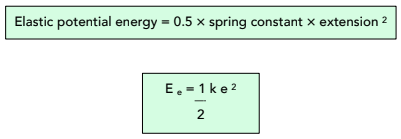
Where:
- elastic potential energy, Ee, in joules, J
- spring constant, k, in newtons per metre, N/m
- extension, e, in metres, m
Question: Callum stretches a spring (which has spring constant 75 N/m). He manages to stretch it from 40cm to 65cm. Calculate the elastic potential energy that is now stored in the spring in Joules.
1. Write out the formula.
We need to write out the formula to calculate elastic potential energy.

2. Calculate the extension.
Before we can calculate anything, we need to find the extension of the spring. In this question, we need to watch out for our units, since the extension should be measured in metres.
40cm = 0.4m
60cm = 0.6m
0.6 – 0.4 = 0.2m
3. Substitute in the numbers.
Now that we have a value for the extension, we can simply put the numbers into our equation. We also need to remember to give the units along with our final answer.
Ee = 0.5 x 75 x (0.2)²
Ee = 0.5 x 75 x 0.04
Ee = 1.5J
Gravitational Potential Energy, GPE
Gravity is a force that attracts objects towards the centre of the Earth. In order to overcome the force of gravity and lift an object up, we have to do work, which requires energy.
As an object is lifted into the air, it gains gravitational potential energy (GPE). This energy has been transferred from kinetic or chemical energy. The gain in GPE is equivalent to the amount of work done when lifting the object up.
Just like kinetic energy, the mass is important too. GPE is determined by mass and height.
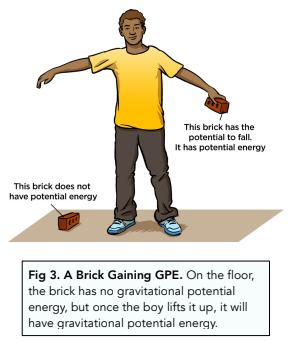
Calculating GPE

We can calculate the amount of gravitational potential energy an object has gained using the following formula.

Where:
- gravitational potential energy, Ep, in joules, J
- mass, m, in kilograms, kg
- gravitational field strength, g, in newtons per kilogram, N/kg
- height, h, in metres, m
Question: Joe weighs 70 kg. He climbs up a tree 12m tall. Calculate his GPE in kJ, giving your answer to 1 decimal place. The value of g as 9.8 N/kg.
1. Write out the formula.
Firstly, we need to write out the correct formula for gravitational potential energy.
E p = m g h
2. Substitute in the numbers.
We need to put in the numbers that we have been given in the question.
Gravitational Potential Energy = 70 x 9.8 x 12
Gravitational Potential Energy = 8232 Joules
3. Give the correct units.
Now we need to give the answer in kJ, since this is what the question asked for.
GPE = 8232 Joules
GPE = 8.2 kJ
Question: A diver weighing 72kg jumps from a height of 20 metres to ground level. What is the loss in gravitational potential energy he experiences? (Assume the gravitational field strength g is 10 N / kg, and that the effects of friction and air resistance are negligible).
E p = m g h
Change in GPE = Mass x 10 x Distance Raised
Change in GPE = 72 x 10 x -20 = – 14400 J
Loss of 14400J GPE
Conversion between KE and GPE
A classic GCSE question discusses the change between GPE and KE for a skydiver. When a person or object falls, GPE is converted to KE.
- The skydiver has maximum GPE before his jump. He is at his highest point possible, so GPE is 100 and KE is 0.
- The skydiver accelerates and GPE is converted to KE. As he begins to fall, he loses height and therefore GPE falls, and gains velocity so KE increases. All GPE lost is converted to KE.
- The skydiver continues to fall and more GPE is converted to KE. As the skydiver falls more and more, GPE continues to be converted to KE.
- Before he hits the ground, GPE is minimum and KE is maximum. As the skydiver is about to hit the ground, his KE will be at its highest level.
- As he hits the ground, GPE and KE become zero. All energy is lost as heat and sound.
Above, we have assumed that all GPE lost is converted to the KE gained. In reality, some energy will be converted to heat and sound due to friction and air resistance.


Question: Peter has climbed up his ladder, of height 3m, to put boxes into his attic. However, he drops a box of old books, of mass 10kg, from the top of the ladder, and they fall to hit the ground below. The books initially fell with a velocity of 20 m/s. What is the kinetic energy of the books just before they hit the ground? (Assume the gravitational field strength g is 10 N / kg, and that the effects of friction and air resistance are negligible).
Ignore the velocity value, as we don’t know the end velocity. The question has given you velocity values to mislead you. Instead we can work out the GPE the box had at its highest point. We can assume all of the GPE energy is transferred to KE, and none lost from the energy transfer due to air resistance and friction.
GPE = 10 x 10 x 3 = 300J.
Question: Two cars are driving up a mountain. Car A travels up to Flag A (height 30m) whilst Car B travels up to Flag B (height 50m). Both hills have a 1 in 5 slope, meaning that the cars ascend 1m for every 5m travelled along the road. Assuming that both cars have a mass of 50kg and travel at 20 m/s, work out the difference in the distance travelled by

each car, the difference in gravitational potential energy at the flag points, and the difference in kinetic energy.
(g = 10 N / kg)

1. Difference in KE
As we are looking for the difference in KE , the Ek=0.5mv² formula can be re-written as:
Ek = 0.5 m v²
Before proceeding with the calculation, we notice that the mass and velocity of the cars is the same. Hence, the difference in kinetic energy is zero!
2. Distance travelled
A = 30 x 5 = 150
B = 50 x 5 = 250
= 100m difference
3. Difference in GPE at Maximum
Ep = m g h
A = 10 x 50 x 30 = 15000
B = 10 x 50 x 50 = 25000
= 10,000J difference
The correct answer is D.
Energy is the ability of an object or system to do work. It comes in many different forms, including kinetic energy, potential energy, thermal energy, and electrical energy.
The law of conservation of energy states that energy cannot be created or destroyed, only transferred from one form to another.
Work is the transfer of energy that results from a force acting on an object and causing it to move in the direction of the force.
Power is the rate at which energy is transferred or transformed per unit time. It is measured in watts (W).
Kinetic energy is the energy an object possesses due to its motion, while potential energy is the energy an object possesses due to its position or state.
The equation for calculating kinetic energy is KE = 1/2mv^2, where KE is the kinetic energy, m is the mass of the object, and v is the velocity of the object.
The equation for calculating gravitational potential energy is GPE = mgh, where GPE is the gravitational potential energy, m is the mass of the object, g is the acceleration due to gravity, and h is the height of the object.
Work is the transfer of energy, and the work done on an object is equal to the change in its energy.
Energy efficiency is the ratio of the useful energy output to the total energy input in a system or process.
Examples of energy transformations include a light bulb converting electrical energy into light energy, a person walking up a flight of stairs converting chemical energy into gravitational potential energy, and a car engine converting chemical energy into kinetic energy.






Still got a question? Leave a comment
Leave a comment